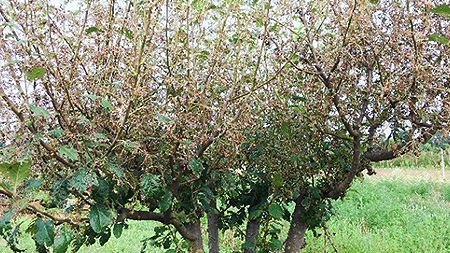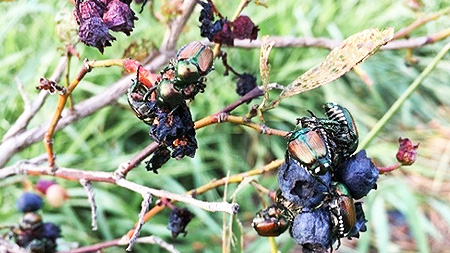About the Beetle
Already more than a century ago, the Japanese beetle (Popillia japonica) has been introduced to New Jersey and has since then developed into a major plant pest in the US. Only recently, it was introduced to Northern Italy and continues to spread. The beetle is eager to feed on hundreds of ornamental plants, fruit trees and berries, vegetable plants, forest trees and arable crops. The adult beetles are only active for a couple of weeks in the summer, but their larvae, typical “grubs”, live underground for the rest of the year, which makes Japanese beetles especially difficult to eradicate.
Already more than a century ago, the Japanese beetle (Popillia japonica) was introduced to New Jersey and has since then developed into a major plant pest in the US. Only recently, it was introduced to Northern Italy and continues to spread. The beetle is eager to feed on hundreds of ornamental plants, fruit trees and berries, vegetable plants, forest trees, and arable crops. The adult beetles are only active for a couple of weeks in the summer, but their larvae, typical “grubs”, live underground for the rest of the year, which makes Japanese beetles especially difficult to eradicate.
How to identify a Japanese beetle
Like typical beetles, Japanese beetles have hardened fore wings, so-called elytra, which are not used for flying but cover the hind part of the insect’s body. These elytra are copper-brown. With their transparent hind wings, they are able to fly but are clumsy flyers and often bonk into objects. Their oval body is about 10 mm long (that’s smaller than a 1-Eurocent-coin, measured without legs!). The head and thorax (middle part) of their body are shimmering in metallic bronze or green, and their wing coverings are copper-brown. Toward their back end, a row of five patches of white, bristle-like hairs covers each side of their body, and there are two white patches on the tip of their back end. The white patches easily distinguish the adult Japanese beetle from other beetles that resemble it. Have a look at our field identification guide to check characters in detail. The grubs (larvae) that develop in the ground cannot be distinguished from similar native grub species without the use of a binocular.
From Asia to North America and Europe
As its name implies, the Japanese beetle originates from northern Japan and the far east of Russia. There, it is a minor pest as it has several natural enemies. Additionally, the local climate and environmental conditions help to prevent massive population growth. In 1916, the Japanese beetle was first discovered in the US, probably introduced with plant material from Japan. After this first discovery outside of its home range, the beetle moved to several other countries, always causing severe damage. Since it was first spotted in northern Italy in 2014, it has rapidly expanded its range, and population levels have exploded. Only four years later, it was discovered for the first time at the southern border of Switzerland in 2017, and continued to spread northwards.
Damage from adult beetles
Adult beetles generally feed on leaves, chewing out the tissue between the veins, only leaving the leaf skeleton. They feed on more than 300 plant species, including vegetable crops, flowering plants, trees, and shrubs. They show a preference for leaves of grapes, fruit-bearing trees, and soy. Besides leaves, they also feed on ripe fruit of mean host plants, for example, plums, cherries, raspberries, blueberries, or apples, and they may even feed on flower petals, for example, rose blossoms. Depending on food supply, they can also feed on the leaves of forest trees, including hazel nut, oaks, or linden.
Damage from grubs
The damage by Japanese beetles is not limited to their adult form. Their larvae feed underground just below the surface, where they consume roots and thereby reduce the vitality and yield of their host plants. These grubs prefer roots of lush pasture and turfgrass but can also feed on roots of maize, beans, tomatoes, strawberries, or nursery seedlings. Predators such as wild boars or crows use the grubs as a food source and cause secondary damage when digging for them. The digging can cause more disruption to the sward than the initial damage by the grubs.
“Is this a Japanese Beetle?” – that’s the question we hear and read hundreds of times per year. In most cases, we can tell within seconds that it is not. You want to know how this works? Then try yourself with our new identification tool! Our easy-to-use field identification key will show you how to discriminate between the Japanese Beetle and its most abundant European relatives.
In regions with a moderate climate, there is one generation of Japanese beetles yearly. The peak flight of adult P. japonica is in July, but adults may be active from Mid-May until September, depending on climate and weather conditions. Females live 30-45 days and can lay up to 60 eggs in this period, preferably in the moist, loamy soil of pastures, meadows, or lawns.
The Japanese beetle is a polyphagous species, meaning that it can feed on numerous host plants/crops. This makes the beetle a threat to agriculture, as its diet also includes important crops such as maize or soy. By feeding on the leaves and the ripe fruit of host plants, the adult beetle harms plant photosynthesis abilities and reduces farmer´s yield and harvest quality. Furthermore, Japanese beetle larvae can also cause substantial damages. The grubs develop beneath the soil and feed on the roots of plants or turf. The damages of the larvae to turf and grassland adversely affects sports facilities such as soccer fields and/or golf courses.
Host plants
The Japanese beetle has over 300 different host plants/crops, implying a wide variety of plants to feed on. Some of these host plants/crops such as soybeans, grapes, apples or blueberries are of economic importance to farmers. Depending on the availability of host crops, the beetle can also feed on the leaves of trees such as hazel nut, oaks, or linden. For a full list of Japanese beetle host plants including classifications into main or secondary host, see Tayeh et al. 2022.
Yield loss estimates from the literature
Depending on the Japanese beetle’s preference for a specific crop, the infestation level and the availability of plant protection products, estimated yield loss can vary greatly. An overview of yield loss estimates for some of the beetle’s main host plants/crops is presented below. Caution should applied to the interpretation of these figures, given that these yield loss estimates depend on the particular study framework and cannot be generalized.
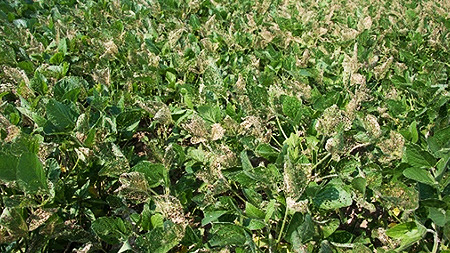
Soy
-
Ribero et al. (2022): reduction in seed size but no total yield damage could be observed (US)
-
EFSA et al. (2019): between 0% - 10% (Europe)
-
Gould (1963): 20% for heavily infested field (US)
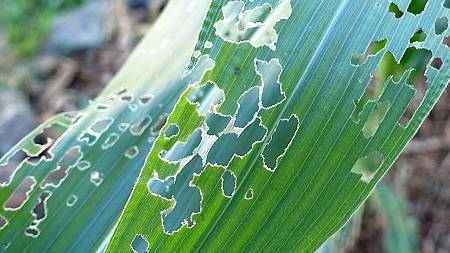
Maize
-
EFSA et al. (2019): between 0% - 10% (Europe)
-
Steckel & Tindall (2013): 0% - 32.4% reduction in total kernel weight (US)
-
Gould (1963): 10 bushels per acre for heavily infested fields (US)
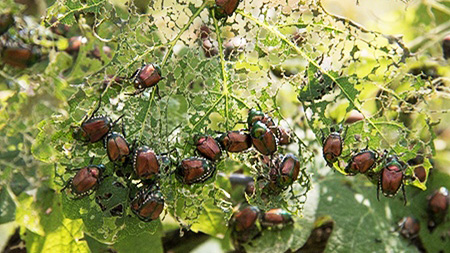
Grapevine
-
Ebbenga et al. (2022): no total yield reduction could be observed but negative impact on quality (US)
-
EFSA et al. (2019): between 1% - 20% (Europe)
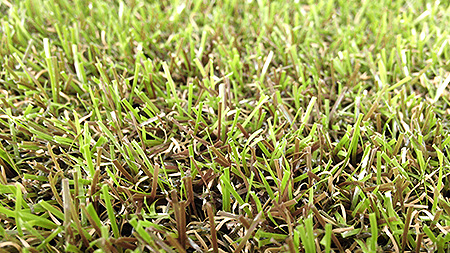
Turf / Grassland
-
EFSA et al. (2019): between 1% - 20% (Europe; turf of sport fields)
-
Ladd & Buriff (1979): between 12% - 100% (bluegrass)
Total damage estimates
The total economic damage caused by the Japanese beetle is composed of direct and indirect economic losses and costs, such as
-
agricultural yield and quality loss,
-
replacement costs,
-
costs and environmental consequences of additional control measures, applied by farmers, private persons as well as national plant protection services,
-
costs to non-agricultural businesses such as golf courses,
-
potential employment loss,
-
costs due to import and export regulations in the event of an infestation, and
-
indirect costs for economic sectors, which are connected or dependent on goods or services from directly affected sectors.
Currently only few studies have tried to estimate above-mentioned costs. According to USDA/APHIS (2015) costs for the control of the Japanese beetle in the US exceed US$460 million per year. In the European Union, the beetle has been ranked the second most important quarantine pest for crops due to its potential severe economic, social and environmental impacts. Even though no extensive damage has officially been reported for the case of Europe, a recent study of the IPM Popillia project found that the potential damage costs could be substantial. The potential yield damage to six main host crops of the beetle ranges from €30 million to €7.8 billion per year. Large grape and wine producing countries like France or Italy would be affected with potential annual damage costs of around €92 million and €62 million, respectively.
The migration routes of P. japonica are strongly linked to human-mediated transport. In fact, the species has been shown to move passively on vehicles and goods, making transportation infrastructures (airports, railways and road networks) critical points for the further spread of the insect into new areas (Borner et al., 2023). For example, interceptions in Central Europe, far from the already infested regions, confirm the importance of human transport in the spread of this pest (Borner et al., 2024).
These are known host plants of the Japanese Beetle Popillia japonica.
Chemical control methods:
LLINs:
Long-Lasting Insecticide-Treated Nets (LLINs) represent a relatively new approach in the context of Integrated Pest Management (IPM) for the control of P. japonica. These nets, with fibres impregnated or coated with pyrethroids, are assembled in attract-and-kill devices, to lure and kill adult P. japonica. The insects are attracted by a dual semiochemical lure placed near the nets, they walk on the LLINs for approximately 90 seconds and then become paralyzed and eventually die within minutes. (Marianelli et al., 2019). Both lab and field tests have demonstrated their efficacy in killing beetles and reducing local population density with minimal environmental impact (Paoli et al., 2023). Recent studies indicate that using a single net per hectare may represent a good trade-off between effectiveness and management efforts to lower adult populations in infested areas (Paoli et al., 2024).
Agronomical and Physical practices
Crop rotation:
Grubs do not pose a threat to alsike clover (Trifolium hybridum L.), red clover (T. pratense L.), white clover (T. repens L.), alfalfa (Medicago sativa L.), soybean (Glycine max (L.) Merr.), buckwheat (Fagopyrum esculentum Moench), oats (Avena sativa L.), barley (Hordeum vulgäre L.), common rye (Sécale céréale L.), or orchardgrass (Dactylis glomerata L.). Implementing these crops in rotation helps reducing insect damage (Fleming, 1976).
Tillage:
Cultivating the soil to a depth of 8 cm in summer brings the eggs to the surface, where they are killed by sun and wind. This method destroys about 25 to 30 percent of the eggs. Furthermore, plowing to about 15 cm, followed by disking and harrowing to 8 cm destroyed 40 to 50 percent of the grubs in fallow fields and 25 to 30 percent in sodland. However, in pastures a lower mortality rate occurred due to the breakup of the clods of not always occurred. Instead, using implements that pulverize the soil and prepare the land for planting in one operation proved more effective in killing grubs than the common farm implements; these include "Rototillers" and "Rotocultivators":
One pulverization on fallow or sodland killed about 70 percent of the grubs
- Two about 82%
- Three about 94%
The best results were obtained when the grubs were close to the soil surface, specifically in early fall and late spring (Fleming, 1976).
Kaolin:
Caution is advised because kaolin is washed off by rain. If this treatment is not repeated over time, it will not protect newly developing shoots (Bosio, technical communication).
Biological control methods:
EPN (Entomopathogenic Nematodes):
These organisms have a unique mechanism to kill their hosts: the infective juveniles (Ijs), the only free-living stage of EPN, move in the soil seeking P. japonica larvae. Upon encountering their hosts, the IJs penetrate the larvae through the natural body openings (mouth, anus, and spiracles) or through thin areas of the cuticle. Once inside the larval body, the IJs release symbiotic bacteria, which multiply rapidly, producing toxins and exoenzymes that compromise the insect's immune system, leading to death by septicemia.
Finally, a new group of IJs goes out into the soil and searches for new hosts (Poinar, 1990). The control of P. japonica larvae is more effective when the natural strains of Heterorhabditis bacteriophora are applied against first and second instars larvae (Power et al., 2009; Koppenhöfer and Fuzy, 2004; Marianelli et al., 2018; Torrini et al., 2020). In the case of application against third instars, pre-wintering larvae are more susceptible than post-wintering ones (Paoli et al., 2017). Furthermore, EPN natural strains possess physiological traits well-adapted to local ecological conditions. As a result, they thrive in their native soils and can persist there for years, thereby reducing the need for additional treatments (Gotta et al., 2023).
EPF (Entomopathogenic Fungi):
Entomopathogenic Fungi (EPF), such as Metarhizium spp. and Beauveria spp., act as biological control agents by infecting and killing insects through their cuticle. These fungi grow inside the host until it dies. They are used for the control of P. japonica at both larval and adult stages. EPF treatments are generally applied as conidia or blastospores in the soils. Studies have shown variable results: for instance, Metarhizium brunneum was effective against P. japonica adults but less against larvae (Barzanti et al., 2023; Graf et al., 2023). Furthermore, the use of native strains such as Metarhizium robertsii for the control of larvae has been tested in some fields reporting moderate results (Marianelli et al., 2024).
Predators/parasitoids:
Natural enemies have been identified from the Japanese beetle’s native range (Potter & Held 2002). For its management, at least 47 species of predatory and parasitic insects from Asia and two from Australia were released in the United States (Althoff & Rice, 2022). Out of these, Tiphia vernalis (Fig. 1S3) Rohwer (Hymenoptera: Tiphiidae), proved to be the most effective in reducing P. japonica population densities (Potter & Held 2002).
The female of T. vernalis paralyses the larvae by stinging the host in the ventral nerve cord and oviposits the eggs between the third thoracic and the first abdominal segment (Balock, 1934; Rogers & Potter, 2003). When the larvae emerge as adults, honeydew and floral nectar serve as important food sources for the primary diet of T. vernalis.
For Tiphia vernalis in a stand of turf, the parasitism rate is higher if plants of Paeonia lactiflora are introduced in the target environment (Rogers & Potter, 2004). Also, black cherry (Prunus serotina Ehrh. c.) provides another nectar source that benefits this insect; the presence of nearby nectar sources influences the T. vernalis effectiveness and determines a high parasitization rate. Then, black cherry is another tool to increase the biological control of P. japonica in landscape management (Mclaughin et al., 2022).
Tiphia popilliavora:
Tiphia popilliavora wasp female lays eggs on the first or second thorax segments (Althoff & Rice, 2022); then T. popilliavora larvae feed externally on the host (Balock et al., 1934). Similarly, for T. popilliavora it is recommended to plant peonies or wild parsnip, because they promote the establishment and spread of wasp populations, increasing parasitism rates (Althoff & Rice, 2022).
Istocheta aldrichi:
it is a tachinid fly that parasitizes P. japonica adults. Its eggs are laid on the adult’s prothorax. Then, I. aldrichi larvae move into the internal organs, after their first molt. After the oviposition, P. japonica survives for 5-9 days. However, if spring temperatures are high, early fly emergence will occur, misaligning the adult phenology of the host (Althoff & Rice, 2022).
Saponins:
Saponins extracted from alfalfa (Medicago sativa) are biologically active molecules that have demonstrated anti-feedant and insecticidal effects against P. japonica. They act as a food deterrent causing a significant reduction in the consumption of treated leaves compared to untreated ones. Furthermore, at a concentration of 3% saponins have been observed to increase mortality in P. japonica adults (Iovinella et al., 2023).
REFERENCES
Althoff, E. R., & Rice, K. B. (2022). Japanese beetle (Coleoptera: Scarabaeidae) invasion of North America: history, ecology, and management. Journal of Integrated Pest Management, 13(1), 2.
Balock, J. W. (1934). The Status of Tiphia vernalis Rohwer, an imported Parasite of the Japanese Beetle, at the Close of 1933.
Barzanti, G. P., Enkerli, J., Benvenuti, C., Strangi, A., Mazza, G., Torrini, G., Simoncini, S., Paoli, F., & Marianelli, L. (2023). Genetic variability of Metarhizium isolates from the Ticino Valley Natural Park (Northern Italy) as a possible microbiological resource for the management of Popillia japonica. Journal of Invertebrate Pathology, 197, 107891.
Fleming, W. E. (1976). Integrating control of the Japanese beetle: a historical review (No. 1545). US Department of Agriculture, Agricultural Research Service.
Gotta, P., Ciampitti, M., Cavagna, B., Bosio, G., Gilioli, G., Alma, A., Battisti, A., Mori, N., Mazza, G., Torrini, G., Paoli, F., Santoiemma, G., Simonetto, A., Lessio, F., Sperandio, G., Giaocmetto, E., Bianchi, A., Roversi, P. F., & Marianelli, L. (2023). Popillia japonica–Italian outbreak management. Frontiers in Insect Science, 3, 1175138.
Graf, T., Scheibler, F., Niklaus, P. A., & Grabenweger, G. (2023). From lab to field: biological control of the Japanese beetle with entomopathogenic fungi. Frontiers in Insect Science, 3, 1138427.
Iovinella, I., Barbieri, F., Biazzi, E., Sciandra, C., Tava, A., Mazza, G., Marianelli, L., Cini, A., Roversi, P. F., & Torrini, G. (2023). Antifeedant and insecticidal effects of alfalfa saponins in the management of the Japanese beetle Popillia japonica. Journal of Applied Entomology, 147(8), 651-660.
Koppenhöfer, A. M., & Fuzy, E. M. (2004). Effect of white grub developmental stage on susceptibility to entomopathogenic nematodes. Journal of Economic Entomology, 97(6), 1842-1849.
Marianelli, L., Paoli, F., Torrini, G., Mazza, G., Benvenuti, C., Binazzi, F., Sabbatini Peverieri, G., Bosio, G., Venanzio, D., Giacometto, E., Priori, S., Koppenhöfer, A. M., & Roversi, P. F. (2018). Entomopathogenic nematodes as potential biological control agents of Popillia japonica (Coleoptera, Scarabaeidae) in Piedmont Region (Italy). Journal of Applied Entomology, 142(3), 311-318.
Marianelli, L., Paoli, F., Sabbatini Peverieri, G., Benvenuti, C., Barzanti, G. P., Bosio, G., Venanzio, D., Giacometto, E., & Roversi, P. F. (2019). Long‐lasting insecticide‐treated nets: a new integrated pest management approach for Popillia japonica (Coleoptera: Scarabaeidae). Integrated environmental assessment and management, 15(2), 259-265.
Marianelli, L., Sciandra, C., Iovinella, I., Strangi, A., Simoncini, S., Barbieri, F., Barzanti, G.P., Benvenuti., C., Mazza., G., Paoli, F., Sabbatini Peverieri, G., Amoriello, S., Madonni, L., Innocenti degli, E., Roversi P. F., Graf, T., Grabenweger, G., & Torrini, G. (2024), Popillia japonica Italian outbreak management by means of natural strains of Biological Control Agents, Presented in the Symposium “Bringing it home: Advances in research on the international pest Popillia japonica” during the XXVII International Congress of Entomology Kyoto, Japan, August 25-30, 2024 .
McLaughlin, R., Keller, J., Wagner, E., Biddinger, D., Grozinger, C., & Hoover, K. (2022). Insect visitors of black cherry (Prunus serotina) (Rosales: Rosaceae) and factors affecting viable seed production. Environmental entomology, 51(2), 471-481.
Paoli, F., Marianelli, L., Torrini, G., Mazza, G., Benvenuti, C., Bosio, G., Venanzio, D., Tarasco, E., Klein, M., & Roversi, P. F. (2017). Differential susceptibility of Popillia japonica 3rd instars to Heterorhabditis bacteriophora (Italian strain) at three different seasons. Biocontrol Science and Technology, 27(3), 439-444.
Paoli, F., Iovinella, I., Barbieri, F., Sciandra, C., Sabbatini Peverieri, G., Mazza, G., Torrini, G., Barzanti, G. P., Benvenuti, C., Strangi, A., Bosio, G., Mori, E., Roversi, P. F., & Marianelli, L. (2023). Effectiveness of field‐exposed attract‐and‐kill devices against the adults of Popillia japonica (Coleoptera: Scarabaeidae): a study on duration, form and storage. Pest Management Science, 79(9), 3262-3270.
Paoli, F., Barbieri, F., Iovinella, I., Sciandra, C., Barzanti, G. P., Torrini, G., Sabbatini Peverieri, G., Mazza, G., Benvenuti, C., Sacco, D., Martinetti, D., Roversi, P. F., & Marianelli, L. (2024). Comparison of different attract‐and‐kill device densities to control the adult population of Popillia japonica (Coleoptera: Scarabaeidae). Pest Management Science.
Poinar Jr, G. O. (1990). Taxonomy and biology of Steinernematidae and Heterorhabditidae. Entomopathogenic nematodes in biological control, 54.
Power, K. T., An, R., & Grewal, P. S. (2009). Effectiveness of Heterohabditis bacteriophora strain GPS11 applications targeted against different instars of the Japanese beetle Popillia japonica. Biological Control, 48(3), 232-236.Potter, D. A., & Held, D. W. (2002). Biology and management of the Japanese beetle. Annual review of entomology, 47(1), 175-205.
Potter, D. A., & Held, D. W. (2002). Biology and management of the Japanese beetle. Annual review of entomology, 47(1), 175-205.
Rogers, M. E., & Potter, D. A. (2003). Effects of spring imidacloprid application for white grub control on parasitism of Japanese beetle (Coleoptera: Scarabaeidae) by Tiphia vernalis (Hymenoptera: Tiphiidae). Journal of Economic Entomology, 96(5), 1412-1419.
Rogers, M. E., & Potter, D. A. (2004). Potential for sugar sprays and flowering plants to increase parasitism of white grubs (Coleoptera: Scarabaeidae) by tiphiid wasps (Hymenoptera: Tiphiidae). Environmental Entomology, 33(3), 619-626.
Torrini, G., Paoli, F., Mazza, G., Simoncini, S., Benvenuti, C., Strangi, A., Tarasco, E., Barzanti, G. P., Bosio, G., Cutino, I., Roversi, P. E., & Marianelli, L. (2020). Evaluation of indigenous entomopathogenic nematodes as potential biocontrol agents against Popillia japonica (Coleoptera: Scarabaeidae) in Northern Italy. Insects, 11(11), 804.

